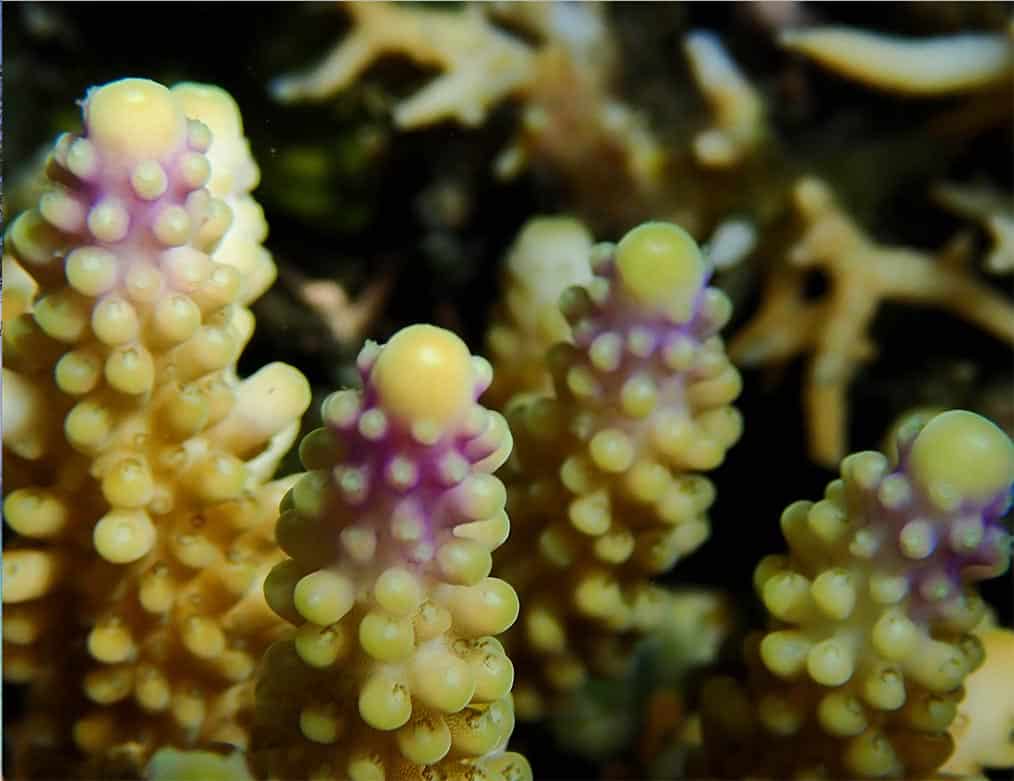The roles of pigments in reef-building corals

The color of coral
The corals that inhabit the oceans fascinate and are admired for their vivid and diverse colors. The color that we perceive is in fact the result of the superposition of the colors of the coral itself and its microalgae [1]. Precisely, the molecules contained in these microalgae, called pigments, are responsible for its color. But since nature is well made, we can wonder if these pigments might not also indirectly have a functional role in corals?
Pigments, Spectrum and Photosynthesis: What do they mean?
Light is an electromagnetic radiation that travels in the form of waves. The range in which this radiation extends is called a “spectrum” (Figure 1).

Figure 1: Spectrum of light
(Source: inrs.fr)
Photosynthesis (transformation of light energy into assimilable organic energy) carried out by the microalgae of the coral represents 80% of the nutrient supply of the latter. However, to carry out this photosynthesis you have to be able to capture the light, this is the role of pigments.
Different pigments absorb different wavelengths of light (Figure 1). However, the rate of photosynthesis, and therefore the energy produced, varies considerably depending on the wavelengths of the light captured.
Also, as there are different pigments, their locations within the coral also vary. For example, those that absorb visible light (400-800 nanometers) are located at the tips of corals, closer to the surface, where light is more abundant [1].
Determining the family of a protein: how do scientists do it and why?
A team of scientists [1] studied a specific blue pigment called pocilloporin. They extracted it from a coral of the Acroporidae family (Figure 2) [1].

Figure 2: Acropora sp.
(Source: Coral Guardian website)
This pigment is also a molecule : a protein. However, each protein has a unique amino acid sequence (primary structure), these amino acids are organized into well-known patterns which form the secondary structure of the protein (ex: Figure 3, the arrows on the scheme represent beta sheets and spirals, the helices). Then, all the secondary structures organize themselves together thanks to biochemical interactions which gives the final 3D shape of the protein. However, it is the latter that gives it its properties.
So after extracting the pigment and analyzing it, the team found its amino acid sequence [1]. They then used bioinformatics tools (MODELLER) to build a 3D model of the structure of this protein (Figure 3). From this model, they discovered that this pigment belongs to the family of green fluorescent proteins (GFP). These proteins emit green light after exposure to UV or visible light [1].

Figure 3: Molecular model of pocilloporin extracted from reef-building corals obtained with MODELLER
(Source: Dove et al. [1])
Functional roles of pigments (pocilloporin) in corals: light capture and protection against strong solar radiation
A bioluminescent organism is an organism that emits light. Proteins are often responsible for this light emission. However, reef-building corals are not known to be bioluminescent, so what are the functions of these pocilloporins?
Strong solar radiation (such as ultraviolet rays) can cause great stress in corals and induce the well-known phenomenon of “coral reef bleaching” [2]. The corals expel the microalgae with which they maintain a very important symbiosis for their survival [2]. Thus, in an environment where there is too much light, some pocilloporins have a role of protecting microalgae against light, as a shield, they are localized in the upper part of the microalga [1].
In addition, other pocilloporins are able to convert this “bad” ultraviolet radiation (300-360nm) into blue light (440-445nm) or blue-green light (480-490 & 500-505nm) [1]. Then, these radiations can be used beneficially by microalgae to carry out photosynthesis [1]. These pocilloporins, located in the lower part of microalgae, therefore improve the amount of total light available for photosynthesis in habitats poor in light [1].
To summarize :
Pigments play an important role in corals. Indeed, some pocilloporins offer a protective role for symbiotic microalgae in high light conditions, others improve the availability of photosynthetic light in low light conditions [1]. Thus, the fact of having different pigments allows photosynthetic microalgae to adapt to the variable lighting conditions of the ocean in terms of quality and quantity, and this whatever the depth, in order to carry out the photosynthesis necessary for the survival of symbiotic corals.
[1]: Dove, S. G., Hoegh-Guldberg, O., & Ranganathan, S. (2001). Major color patterns of reef-building corals are due to a family of GFP-like proteins. Coral reefs, 19 (3), 197-204.
[2]: Glynn, P. W. (1993). Coral reef bleaching: ecological perspectives. Coral reefs, 12 (1), 1-17.

